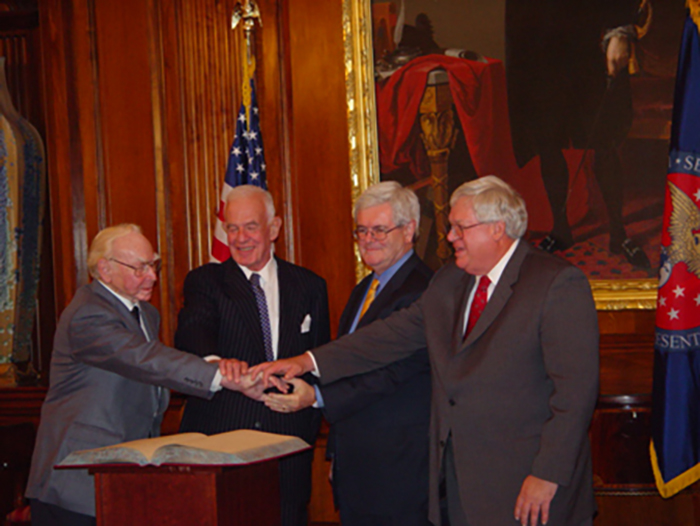New book tells story of Tom Foley, historic speaker of the House

LAWRENCE — People often call for political leaders who can display bipartisanship or lead from the center, avoiding ideological extremes. A new biography tells the story of Thomas Foley, perhaps one of the last American politicians to truly lead from the center, who in the end lost his seat in the rising era of fierce partisanship.
“Tom Foley: The Man in the Middle” by R. Kenton Bird and John Pierce tells the story of the former speaker of the House, his 30-year congressional career, representation of a district that leaned against his party, remarkable ability to build consensus between Republican and Democrat leaders and eventual exit from power.
Pierce, affiliate professor of public affairs & administration at KU, and Bird of the University of Idaho, both have long ties to Foley’s career. The former was an American Political Science Association Congressional Fellow assigned to Foley’s office in the early 1970s. The latter was also an APSA fellow working for Lee Hamilton of Indiana in the following decade. Throughout their careers, both worked closely with Foley and other politicians, journalists, policymakers and leaders. A few years ago, the late Burdett Loomis, an influential political science professor at KU, approached Pierce about a book on Foley.
“He said, ‘Maybe you could do a book on Tom Foley,’” Pierce said of Loomis. “He had started a series on congressional leaders at the University Press of Kansas and thought Foley would make for a good subject. I already had in the back of my mind Kenton as a co-author. He had done his doctoral dissertation on Tom, and I knew he would be perfect for this book.”
Their collaboration resulted in “Tom Foley: The Man in the Middle,” (University Press of Kansas, 2023) that tells the story of Foley’s entry into politics, rise to power within his party and national politics, unique leadership style and stunning defeat that led to his exit from Congress.
The book chronicles Foley’s first election to Congress in 1964 as part of the Democratic landslide of that year. As Foley represented a traditionally Republican-leaning district in eastern Washington, the authors document how what some thought may be a short political life turned into 15 terms and an ascent to the speakership of the House. In fact, when he took the speakers’ gavel in 1989, Foley became the first speaker from a district west of Texas.
Not only did Foley thread the needle of representing a district that largely was made up of constituents not of his party, but he also turned that into a balancing act of advocacy for his home district and leadership within his party, the authors wrote. Bird and Pierce document his time as chair of the House Agriculture Committee. His district was heavily agricultural, which afforded him the chance to benefit his district with projects such as a new powerhouse on the Grand Coulee Dam. He also demonstrated grace and civility when his predecessor as chair was demoted by his party, the authors wrote.
“I think that initial position was where he could show the type of leader he was capable of being. Foley appointed his predecessor (William Poage, D-Texas) vice chair, when he could have been hostile, which I think helped launch him through the leadership ranks,” Pierce said.
The book’s chapters chronicle Foley’s rise from the House Agriculture Committee to House Majority Leader and, ultimately, his historic selection as speaker of the House in 1989. The authors point out how his experience in representing a largely Republican district enabled him to build coalitions that were key in landmark legislation, including the Americans with Disabilities Act, reauthorization of the Clean Air Act, deficit reduction legislation and passage of the North American Free Trade Agreement.
But while he “helped lower the temperature of the House,” Foley eventually fell from power. In 1994, he became the first speaker to lose a reelection campaign since the era of Abraham Lincoln. That loss was part of a “perfect storm” that led to Democrats losing the House majority for the first time since 1955, Bird and Pierce wrote. The Newt Gingrich-led “Republican landslide” of 1994 ushered in the era of fierce partisanship and strict ideology that persists today. But while the backlash to the early Clinton administration and traditional loss of seats by the president’s party were part of the reason for Foley’s loss, the authors dug deeper.
“One thing I think was overlooked at the time was the fact of having a likable, credible candidate in George Nethercutt,” Bird said of Foley’s opponent. “Before that, he had run against a series of candidates who were, to put it charitably, not as pleasant, or as high quality of a candidate as Nethercutt. That was certainly a factor.”
“The Man in the Middle” details Foley’s post-Congress legacy, including his service as U.S. ambassador to Japan and the stamp he left on the body, including his deep respect for the institution of Congress, ability to hold the center and model for the speakership he tried to project in his 5 1/2 years with the gavel.
Bird and Pierce’s long histories working with Foley, as well as their trainings as a journalist and political scientist, respectively, put them in a solid position to pen the biography of a unique American political leader, whose traits are rare in today’s American political landscape.
“He was a brilliant guy and very kind. But not weak,” Pierce said of Foley. “One of the challenges for us as political scientists and journalists was what kind of context to put his career in, in terms of his leadership style. He was not a vociferous, in-your-face leader. But he had a clear leadership style, which led to the book’s title, in reference to his coalition building and respect for the institution.”
Top image: Tom Foley, second from left, with other speakers of the House, from left, Jim Wright, Newt Gingrich and Dennis Hastert. Credit: Wikimedia Commons.